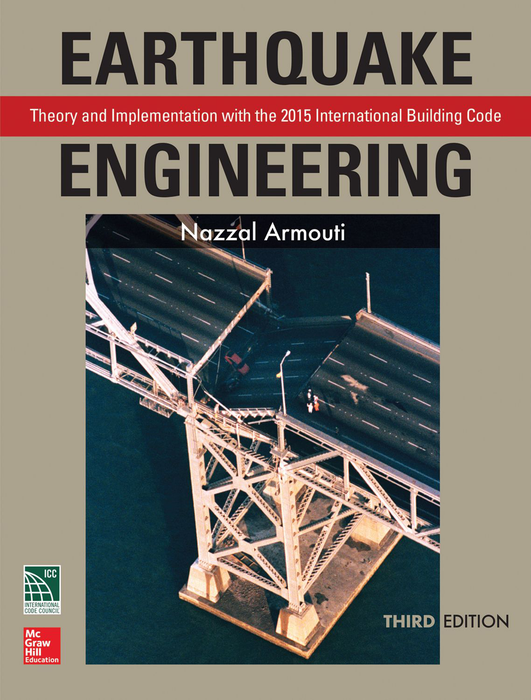
Earthquake Engineering Theory and Implementation with the 2015 International Building Code
Product Code/ISBN: 4035S3
$234.95
Know everything there is to know about structures and earthquakes with this incredible manual. It covers different engineering methods, practical instruction and implementation, and cost-effective ideas to help protect you and your buildings from the next big shake. Other information includes seismic isolation, foundation designs, and other geotechnical aspects of earthquakes.
Table of Contents
- Introduction
- Characteristics of Earthquakes
- Causes of Earthquakes
- Plate Tectonic Theory
- Measures of Earthquakes
- Magnitude
- Intensity
- Instrumental Scale
- Fourier Amplitude Spectrum
- Power Spectral Density
- Response Spectrum
- Linear Elastic Dynamic Analysis
- Introduction
- Single Degree of Freedom System
- System Formulation
- Response Spectrum of Elastic Systems
- Design Response Spectrum
- Generalized Single Degree of Freedom
- Multiple Degrees of Freedom System
- Multiple Degrees of Freedom System in 2D Analysis
- Multiple Degrees of Freedom Systems in 3D Analysis
- Mass Participation in Buildings
- Shear Beam
- Cantilever Flexure Beam
- Simple Flexure Beam
- Axial Beam
- Finite Element Method
- Finite Element Concept in Structural Engineering
- Stiffness Matrix (Virtual Work Approach)
- Mass Matrix (Virtual Work Approach)
- Stiffness and mass Matrices (Galerkin Approach)
- Other Matrices
- Mass Matrix in 2D
- Application of Consistent Mass Matrix
- Incoherence
- Problems
- Nonlinear and Inelastic Dynamic Analysis
- Introduction
- Single Degree of Freedom System
- Numerical Methods
- Central Differences Method
- Newmark Methods
- Wilson Method
- Multiple Degrees of Freedom System
- Equivalent Linearization
- Problems
- Behavior of Structures Under Seismic Excitation
- Introduction
- Force-Reduction Factor, R
- Ductility
- Energy Dissipation Capacity
- Self-Centering Capacity
- Frequency Shift
- Relationship Between Force Reduction and Ductility Demand
- Equal Displacement Criterion
- Equal Energy Criterion
- General Relationship Between R and ud
- Relationship Between Global Ductility and Local Ductility
- Local Ductility Capacity
- Evaluation of Monotonic Local Ductility Capacity
- Monotonic Behavior of Concrete
- Monotonic Behavior of Steel
- Idealized Strain Compatibility Analysis
- General Strain Compatibility Analysis
- Evaluation of Cyclic Local Ductility Capacity
- Cyclic Behavior of Concrete
- Cyclic Behavior of Steel
- Cyclic Strain Compatibility Analysis
- Precast Concrete Structures
- Effect of Structure Configuration on Ductility
- Second-Order Effect on Ductility
- Undesirable Hysteretic Behavior
- Effect of Axial Load on Hysteretic Behavior
- Rigid Bar Idealization
- Case 1: Rigid Bar Under Axial Load and Without Springs
- Case 2: Rigid Bar with Springs and Without Axial Load
- Case 3: Rigid Bar with Springs and Under Axial Load
- Energy Dissipation Factor (aN)
- Design Considerations
- Capacity Design
- Pushover Analysis
- Recommended Versus Undesirable Structural Systems
- Strain Rate
- Problems
- Introduction
- Design of Earthquake – Resistant Buildings (IBC)
- Introduction
- Definition of Structural Components
- Seismic Base
- Seismic Design Category
- Zoning Classification
- Response Spectra
- Design Requirements of Seismic Design Categories
- Seismic Design Category A
- Seismic Design Category B and C
- Seismic Design Category D, E, and F
- Earthquake-Induced Forces
- Regularity of Structures
- Simplified Lateral Force Analysis Procedure
- Equivalent Lateral Force Procedure
- Modal Response Spectrum Analysis
- Two-Stage Analysis Procedures
- Time-History Analysis
- Directional Effect
- Load Combinations
- Definitions and Requirements of Structural Systems
- Special Topics
- Diaphragm Design Forces
- Torsional Effect
- Drift Limitations
- Structural Separation
- P Effect
- Problems
- Seismic Provisions of Reinforced Concrete Structures (ACI 318)
- Introduction
- Ordinary Moment Frames
- Ordinary Beams
- Ordinary Beam-Columns
- Intermediate Moment Frames
- Intermediate Beams
- Intermediate Beam-Columns
- Special Moment Frames
- Special Beams
- Special Beam-Columns
- Special Joints
- Ordinary Shear Walls
- Special Shear Walls
- Special Shear Walls Without Openings
- Special Shear Walls with Openings
- Coupling Beams
- Detailing of Coupling Beam with Diagonals
- Diaphragms and Trusses
- Structural System
- Shear Strength
- Diaphragm Chords and Truss Members
- Foundations
- Strength Requirements
- Detailing Requirements
- Precast Concrete
- Precast Special Moment Frames
- Precast Intermediate Shear Walls
- Pre3cast Special Shear Walls
- Nonseismic-Resisting Systems
- General Requirements
- Introduction to AISC Seismic Provisions for Structural Steel Buildings
- Introduction
- General Requirements
- Structural Systems
- Ordinary Moment Frames
- Intermediate Moment Frames
- Special Moment Frames
- Special Truss Moment Frames
- Ordinary Cantilever Column Systems
- Special Cantilever Column Systems
- Ordinary Concentrically Braced Frames
- Special Concentrically Braced Frames
- Eccentrically Braced Frames
- Buckling-Restrained Braced Frames
- Special Plate Shear Walls (SPSW)
- Allowable Stress Design Approach
- Design of Earthquake-Resistant Bridges (AASHTO Code)
- Introduction
- AASHTO Procedures for Bridge Design
- Response Spectra
- Single Span Bridges
- Bridges in Seismic Zone 1
- Bridges in Seismic Zone 2
- Bridges in Seismic Zones 4 and 5
- Methods of Analysis
- Uniform Load Method
- Single-Mode Spectral Method
- Multiple Mode Spectral Method
- Time-History Method
- Directional Effect
- Load Combinations
- Design Requirements
- Design Requirements of Reinforced Concrete Beam-Columns
- Bridges in Seismic Zone 1
- Bridges in Seismic Zone 2
- Bridges in Seismic Zones 3 and 4
- Design Requirements of Reinforced Concrete Pier Walls
- Special Topics
- P-Change Requirements
- Displacement Requirements (Seismic Seats)
- Longitudinal Restrainers
- Hold-Down Devices
- Liquefaction
- Geotechnical Aspects and Foundations
- Introduction
- Wave Propagation
- Ground Response
- Liquefaction
- Slope Stability
- Lateral Earth Pressure
- Foundations
- Synthetic Earthquakes
- Introduction
- Fourier Transform
- Power Spectral Density
- Stationary Random Processes
- Random Ground Motion Model
- Implementation of Ground Motion Model
- Validity of Synthetic Earthquakes
- Seismic Isolation
- Introduction
- Concept of Seismic Isolation
- Lead-Rubber Bearing Isolators
- Analysis of Seismically Isolated Structures
- Design of Seismically Isolated Structures
